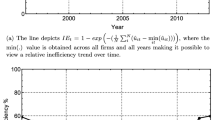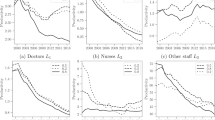Abstract
Since demand for hospital services is subject to substantial variability, the relationship between uncertain demand, excess capacity, hospital costs and performance should be investigated thoroughly. In this paper a waiting time indicator to proxy hospital standby capacity is incorporated into a multi-product translog cost function for Belgian general care hospitals. The indicator is derived from queuing theory and improves on the conventionally used (inverse of the) occupancy rate. The multi-product stochastic frontier specification allows calculation of cost elasticities and marginal cost of seven hospital departments, as well as the degree of economies of scale and scope and enables identification of differences in efficiency.



Similar content being viewed by others
Notes
If this assumption is left, calculation of the typical queuing indicators becomes very complicated and it is often not possible to derive exact closed form expressions.
The typical queuing term “utilisation rate” is equal to the “occupancy rate” which was used in the sections describing hospital cost function studies that accounted for uncertain demand.
Unfortunately we don’t have data on the number of beds per department.
Using L’Hôpital’s rule: \({\mathop {\lim }\limits_{\lambda _B \to 0} \frac{y_i^{\lambda _B} -1}{\lambda _B }=\ln y_i }\)
National Institute for Sickness and Invalidity Insurance.
Under this system inefficient hospitals have their budget decreased.
82 specialised hospitals (mostly psychiatric) were not included in this analyses. Because of their nature they often only provide one specific treatment (output) which makes it almost impossible to compare them with general care hospitals.
Because of the long history of involvement of the Catholic Church in the provision of health care, the majority of hospital care is provided by state-subsidised, not-for-profit (catholic) private initiative, i.e. most private hospitals are owned by religious charitable orders. The public and the private (not-for-profit) sectors operate in the same market and receive more or less comparable levels of resources.
A model including input prices and using cost share equations generated poor results.
It is also possible to specify own starting values.
Unfortunately, more detailed variables such as a casemix indicator were not available.
HHI is calculated as the sum of the squared local market shares (measured in number of beds).
These indicators are on the level of the town in which the hospital is located and were obtained from ECODATA, FOD Economie, K.M.O., Middenstand &Energie.
References
Bagust A, Place M, Posnett JW (1999) Dynamics of bed use in accommodating emergency admission: stochastic simulation model. Br Med J 319:155–158
Battese GE, Coelli TJ (1995) A model for technical inefficiency effects in a stochastic frontier production function for panel data. Emp Econ 20:325–332
Baumol WJ, Panzar JC, Willig RD (1988) Contestable markets and the theory of industry structure. Harcourt Brace Jovanovich, San Diego
Bilodeau D, Crémieux P, Ouellette P (2000) Hospital cost function in a non-market health care system. Rev Econ Stat 82:489–498
Carey K (1998) Stochastic demand for hospitals and optimizing “excess” bed capacity. J Reg Econ 14:165–187
Caves DW, Christensen LR, Tretheway MW (1980) Flexible cost functions for multiproduct firms. Rev Econ Stat 62:477–481
Coelli T (1995) Estimators and hypothesis tests for a stochastic production frontier function: a monte carlo analysis. J Prod Anal 6:247–268
Coelli T (1996) A Guide to FRONTIER Version 4.1: A computer program for stochastic frontier production and cost function estimation, centre for efficiency and productivity analysis. University of New England, Armidale, Australia, Working Paper, no. 96/07, 1–33
Coelli T, Rao DS, Prasada Battese GE (1998) An introduction to efficiency and productivity analysis. Kluwer Academic Publishers, Boston/Dordrecht/London
Conrad RF, Strauss RP (1983) A multiple-output multiple-input model of the hospital industry in North Carolina. Appl Econ 15:341–352
Cowing TG, Holtmann AG (1983) Multiproduct short-run hospital cost functions: empirical evidence and policy implications from cross-section data. South Econ J 49:637–653
Dawson D, Goddard M, Street A (2001) Improving performance in public hospitals: a role for comparative costs? Health Policy 57:235–248
Folland ST, Hofler RA (2001) How reliable are hospital efficiency estimates? exploiting the dual homothetic production. Health Econ 10:683–698
Friedman B, Pauly M (1981) Cost functions for a service firm with variable quality and stochastic demand: the case of hospitals. Rev Econ Stat 63:620–624
Fujii A (2001) Determinants and probability distribution of inefficiency in the stochastic cost frontier of Japanese hospitals. Appl Econ Lett 8:807–812
Fujii A., Ohta M. (1999) Stochastic cost frontier and cost inefficiency of japanese hospitals: a panal data analysis. Appl Econ Lett 6:527–532
Gaynor M, Anderson GF (1995) Uncertain demand the structure of hospital costs and the cost of empty hospital beds. J Health Econ 14:291–317
Graham GG, Cowing TG (1997) Hospital reserve margins: structural determinants and policy implications using cross-section data. South Econ J 63:692–709
Grannemann TW, Brown RS, Pauly MV (1986) Estimating hospital costs. a multiple-output analysis. J Health Econ 5:107–127
Greene WH (1997) Econometric analysis, 3rd edn. Prentice Hall Upper Saddle River, New Jersey
Hillier FS, Lieberman GJ (1995) Introduction to operations research, 6th edn. Industrial Engineering Series, McGraw-Hill, New York e.a.
Hughes D, McGuire A (2003) Stochastic demand, production responses and hospital costs. J Health Econ 22:999–1010
Jacobs R (2001) Alternative methods to examine hospital efficiency : data envelopment analysis and stochastic frontier analysis. Health Care Manage Sci 4:103–115
Jacobzone S (1999) De Beheersing van de Uitgaven en de Verantwoordelijkheid van de Actoren in de Gezondheidssystemen, in RIZIV Jaarverslag 1999, RIZIV, Brussel, pp 106–117
Johnson NL, Kotz S (1970) Distributions in statistics: continuous univariate distributions-1, The Houghton Mifflin series in statistics. Houghton Mifflin Company, Boston e.a.
Joskow PL (1980) The effect of competition and regulation on hospital bed supply and the reservation quality of the hospital. Bell J Econ 11:421–447
Keeler TE, Ying JS (1996) Hospital costs and excess bed capacity: a statistical analysis. Rev Econ Stat 78:470–481
Li T, Rosenman R (2001) Cost inefficiency in Washington hospitals: a stochastic frontier approach using panel data. Health Care Manage Sci 4:73–81
Mulligan JG (1985) The stochastic determinants of hospital-bed supply. J Health Econ 4:177–181
Nahmias S (1993) Production and operations analysis, 2nd edn. Irwin, Burr Ridge, Illinois; Boston, Massachusetts and Sydney, Australia
NHS Centre for Reviews and Dissemination (1996) Concentration and choice in the provision of hospital services. The relationship between volume and the scope of activity and hospital costs, CDR Report 8 (part II), University of York, York
Pauly MV, Wilson P (1986) Hospital output forecasts and the cost of empty hospital beds. Health Ser Res 21:403–428
Rosko MD (2001) Cost efficiency of US hospitals: a Stochastic frontier approach. Health Econ 10:539–551
Smet M (2002) Cost characteristics of hospitals. Soc Sci Med 55:895–906
Smet M (2004) Multi-product costs and standby capacity derived from Queuing Theory: the case of Belgian hospitals. Appl Econ 36:1475–1487
Street A, Jacobs R (2002) Relative performance evaluation of the English acute hospital sector. Appl Econ 34:1109–1119
Vita MG (1990) Exploring hospital production relationships with flexible functional forms. J Health Econ 9:1–21
Webster R, Kennedy S, Johnson L (1998) Comparing techniques for measuring the efficiency and productivity of Australian private hospitals, Working papers in econometrics and applied statistics. Australian Bureau of Statistics, no. No. 98/3, 1–60
Acknowledgments
The author would like to thank Diana De Graeve, Walter Nonneman, Wilfied Pauwels and two anonymous referees of this journal for their useful comments on ealier versions of this paper. I also wish to thank the Belgian Federal Ministry of Social Affairs, Public Health and the Environment for providing the data for this study. However, the author is the sole responsible for the empirical analysis and conclusions presented here.
Author information
Authors and Affiliations
Corresponding author
Rights and permissions
About this article
Cite this article
Smet, M. Measuring performance in the presence of stochastic demand for hospital services: an analysis of Belgian general care hospitals. J Prod Anal 27, 13–29 (2007). https://doi.org/10.1007/s11123-006-0021-7
Published:
Issue Date:
DOI: https://doi.org/10.1007/s11123-006-0021-7
Keywords
- Hospital costs
- Stochastic demand
- Efficiency
- Productivity
- Stochastic frontier analysis
- Econometrics
- Queuing theory
- Multi-product cost function




